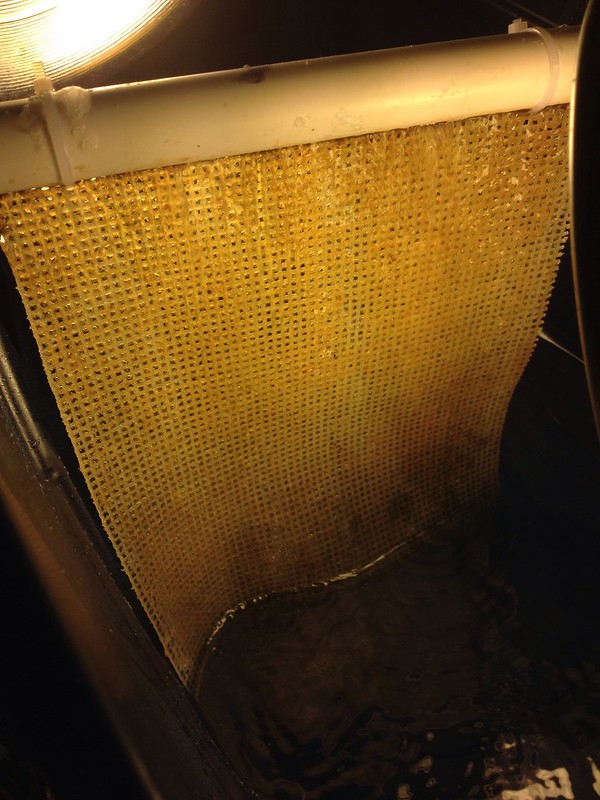Pics of your sump would help.
Yea you don't want aluminum. Use plastic canvas #7 mesh from the bay or from everythingplasticcanvas.com
As for the source of the N and P:
What do all algae (and cyano too) need to survive? Nutrients. What are nutrients? Ammonia/ammonium, nitrite, nitrate, phosphate and urea are the major ones. Which ones cause most of the algae in your tank? These same ones. Why can't you just remove these nutrients and eliminate all the algae in your tank? Because these nutrients are the result of the animals you keep.
So how do your animals "make" these nutrients? Well a large part the nutrients come from pee (urea). Pee is very high in urea and ammonia, and these are a favorite food of algae and some bacteria. This is why your glass will always need cleaning; because the pee hits the glass before anything else, and algae on the glass consume the ammonia and urea immediately (using photosynthesis) and grow more. In the ocean and lakes, phytoplankton consume the ammonia and urea in open water, and seaweed consume it in shallow areas, but in a tank you don't have enough space or water volume for this, and, your other filters or animals often remove or kill the phytoplankton or seaweed anyway. So, the nutrients stay in your tank.
Then the ammonia/ammonium hits your rocks, and the periphyton on them consumes more ammonia and urea. Periphyton is both algae and animals, and is the reason your rocks change color after a few weeks. Then the ammonia goes inside the rock, or hits your sand, and bacteria there convert it into nitrite and nitrate. However, the nutrients are still in your tank.
Also let's not forget phosphate, which comes from solid organic food particles. When these particles are eaten by microbes and clean up crew, the organic phosphorus in them is converted into phosphate. However, the nutrients are still in your tank.
So whenever you have algae "problems", you simply have not exported enough nutrients compared to how much you have been feeding (note: live rock can absorb phosphate for up to a year, making it seem like there was never a problem. Then, there is a problem).
So just increase your nutrient exports. You could also reduce feeding, and this has the same effect, but it's certainly not fun when you want to feed your animals :)
Skimmers don't remove nutrients; only food particles. Pellets should help, but reduce pH and can harm corals. Canister is only hurting. De-nitrate should help. Waterchanges only remove a small part, and only that day.
Yes you probably have rocks full of P.
Here are some size guidelines:
Scrubbers are sized according to feeding. Nutrients "in" (feeding) must equal nutrients "out" (scrubber growth), no matter how many gallons or liters you have. So...
An example VERTICAL upflow or waterfall screen size is 3 X 4 inches = 12 square inches of screen (7.5 X 10 cm = 75 sq cm) with a total of 12 real watts (not equivalent) of fluorescent light for 18 hours a day. If all 12 watts are on one side, it is a 1-sided screen. If 6 watts are on each side, it is a 2-sided screen, but the total is still 12 watts for 18 hours a day. This screen size and wattage should be able to handle the following amounts of daily feeding:
1 frozen cube per day (2-sided screen), or
1/2 frozen cube per day (1-sided screen), or
10 pinches of flake food per day (2-sided screen), or
5 pinches of flake food per day (1-sided screen), or
10 square inches (60 sq cm) of nori per day (2-sided screen), or
5 square inches (30 sq cm) of nori per day (1-sided screen), or
0.1 dry ounce (2.8 grams) of pellet food per day (2-sided screen), or
0.05 dry ounce (1.4 grams) of pellet food per day (1-sided screen)
High-wattage technique: Double the wattage, and cut the hours in half (to 9 per day). This will get brown screens to grow green much faster. Thus the example above would be 12 watts on each side, for a total of 24 watts, but for only 9 hours per day. If growth starts to turn YELLOW, then increase the flow, or add iron, or reduce the number of hours. And since the bulbs are operating for 9 hours instead of 18, they will last 6 months instead of 3 months.
HORIZONTAL screens: Multiply the screen size by 4, and the wattage by 1 1/2. Flow is 24 hours, and is at least 35 gph per inch of width of screen [60 lph per cm], EVEN IF one sided or horizontal.
FLOATING SURFACE SCRUBBERS WITH RIBBONS: Screen size is the size of the box (Lenth X Width), and is 2-sided because the ribbons grow in 3D.
LEDs: Use half the wattage as above. 660nm (red) is best. You can mix in a little 450nm (blue) if you want.
Very rough screen made of roughed-up-like-a-cactus plastic canvas, unless floating surface, which would use gravel and strings instead.
Clean algae:
Every 7 to 21 days, or
When it's black, or
When it fills up, or
When algae lets go, or
When nutrients start to rise

